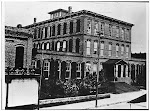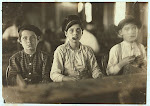Tony Pizzo remembered Seventh Avenue (La Gran Septima Avenida[1]) as a “vibrant main drag.” The best stores were there and stayed open until eleven p.m. on Saturday nights, because it was pay day for the cigar workers. Everyone got dressed up to go down to Seventh Avenue. [2] Cuban, Italian, and Spanish families and vendors crowed the streets and sidewalks, bumping into each other it was so busy. People sat in chairs in the street, remembered Rosemary Craparo. [3] When the shops closed, then the dances would start in the Latin clubs.[4]
“The Septima” was also shared with the electric streetcar or trolley. El Carrito Eléctrica was first installed in the 1890s. “By 1913 Tampa Electric Street Railway System” connected Ybor City to all of the important areas of Tampa with sixty-seven coaches and fifty-three miles of track. Frank Trebín Lastra remembers that during the 1920s through 1940s when he was growing up there, that the trolleys “were painted a soft yellow and their presence gliding through the streets seemed inviting, reassuring, and exciting-like the visit of a friend. The entire family rode on them. Children loved them, and many mothers and fathers rode them daily to get to their distant factories, though within the core area most walked to the local factories. Their slow operating speed was perfectly suited to Ybor City’s small grid.” The street cars began operating at 5:30 a.m. and stopped between midnight and 1 a.m. The trolley system was shut down in 1946. However, in recent years a trolley line, called Teco Line Streetcar System became operational. It connects Ybor City to downtown Tampa with vintage Ybor cars painted yellow.[5]
The Gaceta, "the Nation's only tri-lingual newspaper and one of the oldest minority-owned and targeted newspapers in America."
http://www.lagacetanewspaper.com/
The Gaceta, "the Nation's only tri-lingual newspaper and one of the oldest minority-owned and targeted newspapers in America."
http://www.lagacetanewspaper.com/
Merchant Marines WWII:
In searching for information about the Merchant Marines WWII I came across this site containing military information for all wars, and branches of services.
[1] Gary R. Mormino and George E. Pozzetta, The Immigrant World of Ybor City, Italians and Their Latin Neighbors in Tampa, 1885-1985, (Urbana and Chicago: University of Illinois Press, 1987),245.
[2] Tony Pizzo and Interviewer, “Tony Pizzo’s Ybor City,” Tampa Bay History, 2 no. 1 (Spring/Summer 1980).
[3] Gary R. Mormino and George E. Pozzetta, “Immigrant Women in Tampa: The Italian Experience, 1890-1930,” Florida Historical Quarterly, 61 (1982-1983), 245, 246,309.
[4] Tony Pizzo and Interviewer, “Tony Pizzo’s Ybor City,” Tampa Bay History, 2 no. 1 (Spring/Summer 1980).
[5] Frank Trebín Lastra, Ybor City, the Making of a Landmark Town, (Tampa: University of Tampa Press, 2006), 98, 112, 115.







No comments:
Post a Comment